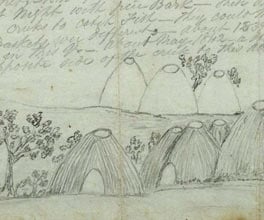Indigenous land use
Before European settlement, the area we now call 'Victoria' was divided into as many as 32 different Indigenous language groups.
These groups (often referred to as 'tribes') spoke different languages, built different types of housing and practised different types of farming. Like the Europeans who were to follow, the Indigenous population manipulated the environment to their own ends.
When Major Thomas Mitchell first made his way through the Port Phillip district in winter of 1836 he was struck by how much some of the landscape resembled Europe. Australia’s Indigenous people had shaped the land:
The world of the Australians was as moulded by conscious human action as were the hedgerowed fields of England. If one used the plough and the iron axe to shape their world, the other used fire and the stone axe.
- Robert Kenny
Kenny, R 2008, When the Lamb Enters the Dreaming, Scribe, Melbourne, Vic.
In recent years archaeologists have uncovered just how sophisticated the farming practices employed by some Indigenous groups in Victoria were. The Gunditjmara people, in particular, engineered and constructed a sophisticated system in the Lake Condah region. This system was used to farm huge quantities of eel, enough to feed up to 10,000 people. According to archaeologist, Heather Builth:
The Gunditjmara weren’t just catching eels, their whole society was based around eels…The villages associated with the Lake Condah fish farm…were actually more like company towns, with dwellings built to house the people who worked the farms. It’s like you have your council houses for the factory. That’s what was going on here.
- Heather Builth
Builth H, in Phillips, G 2003 The Age, 'New evidence shows Aborigines lived in villages and farmed fish 8000 years', viewed April 2011, <http://www.theage.com.au/articles/2003/03/12/1047431092972.html>
In Western or European thinking traditions, societies become more 'sophisticated' when they have a surplus of food. People can devote more time to devote to things other than just basic survival, including more elaborate housing.
Dawson points out that the residences were formed with a frame of stouts limbs, tall enough for a person to stand upright in and that this dome-shaped frame was clad in grass and covered over with turf, “like slates on a roof”. He is at pains to demonstrate that these were strong and comfortable abodes...
- Ray Madden
Madden R 2010, 'James Dawson’s Scrapbook: advocacy and antipathy in colonial Western Victoria' in The La Trobe Journal, State Library of Victoria Foundation, Vol. 85, Melbourne, Vic.
The Gunditjmara were living on some of the most fertile land in the Port Phillip district, land that the European settlers wanted. The Eumeralla Wars that ensued were a series of armed conflicts that were recently acknowledged by a High Court decision that recognised the rights and interests of the Gunditjmara over 140,000 hectares of land around Portland and Port Fairy.











